This section looks at foundations from the outside and treats the problems you are most likely to en counter there. A previous section covers the elements of a foundation below the ground. Various foundation constructions are discussed elsewhere on this site.
MAINTAINING A FOUNDATION
Once or twice a year, preferably just after a heavy rain, examine the foundation walls of your home from the out side. Look for deteriorating mortar joints and repair any you find. Diagonal or stepped cracks usual l result from settling, which may or may not be a serious problem. If such a crack develops or widens, consult a ma son or basement specialist.
Check all points where outdoor faucets, conduit, ventilators, and other items penetrate the foundation, and wherever other materials, such as siding or basement windows, are in contact with the foundation. These must be tightly sealed with caulk. If the caulking is failing, scrape it away and re-caulk). The bottommost courses of siding or wood shingles are the most susceptible to water damage. If any members are cracked or rotting, replace them. Also trim back any shrubbery that's in con tact with siding.
Clear out any leaves or debris in window wells. Look for signs of soil erosion around the foundation. Erosion indicates a drainage problem that could eventually weaken the foundation.
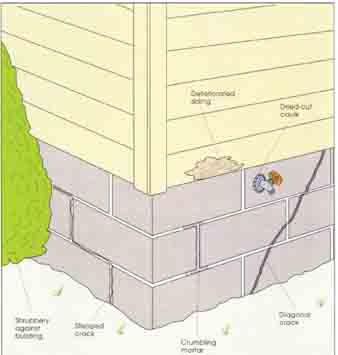 INSPECT FOUNDATIONS at least once a year. If you find
any of these problems, remedy them at once. Stepped cracks and diagonal
cracks indicate settling and should be examined by a contractor or a
mason.
INSPECT FOUNDATIONS at least once a year. If you find
any of these problems, remedy them at once. Stepped cracks and diagonal
cracks indicate settling and should be examined by a contractor or a
mason.
CHECKING FOR TERMITES
Although they don't pose a threat to a masonry foundation, subterranean termites often construct mud shelter tubes across masonry to get to wood elements. Shelter tubes on walls or sup port posts are a sure sign of termites, but these destructive insects can enter a home in other, not-visible ways.
The best time to look for evidence of termites is in the spring or early summer, when they grow wings and swarm. To distinguish between termites and harmless flying ants, look for the following: Ants have narrow waists, bent antennae, and two sets of wings that are dissimilar. Termites have thick waists, straight antennae, and four wings that are similar in shape, size, and pattern. A large number of discarded wings on the ground or window sills tells you that in sects have swarmed.
EXTERMINATING TERMITES
If you suspect that termites are attacking your home, don't panic. They destroy wood very slowly, and it's highly unlikely that your house is in danger of collapsing. You should, however, en gage a pest control service to wipe out the termite colony. Because strong chemicals and special equipment are required, extermination is not a do-it- yourself project Subterranean termites must return to the soil periodically to absorb moisture. An exterminator injects chemicals deep into the ground around the perimeter of a home, creating a poison barrier that the termites can't cross. Termites in side the house are unable to leave and die in a matter of days. The termites in the ground, deprived of access to their wood fiber diet, starve or go elsewhere.
VENTING CRAWL SPACES
If your home’s foundation encloses a crawl space, shine a strong light inside during the heating season and at the height of summer. Signs of moisture on insulation or framing indicate that the crawl space is not properly ventilated.
One way to solve a moisture problem is to lay a polyethylene vapor barrier on the ground inside the crawl space. If the problem occurs during the heating season, open the crawl space vents. Otherwise, keep the vents closed in the cold months and fully open in summer.
A crawl space without a vapor barrier should have 1 square foot of vent for each 150 square feet of floor area, with a minimum of four vents. With a vapor barrier, the requirement is 1 square foot of vent for each 1,500 square feet of floor area, with at least two vents, located at diagonally opposite corners of the space. Louvers on vents impede airflow, so you must double or triple the size of the opening called for.
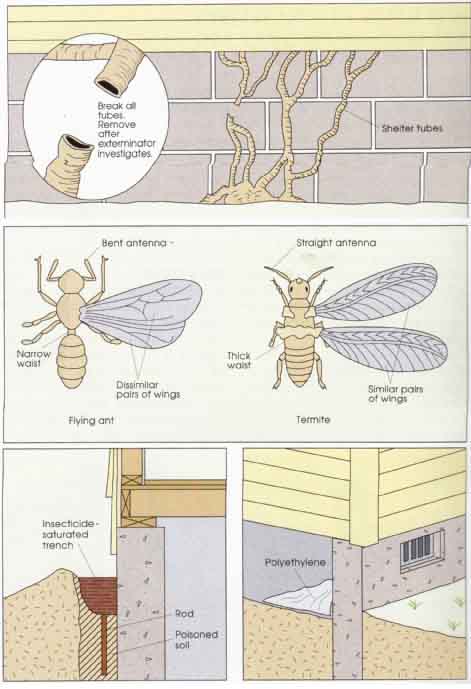
TERMITES CONSTRUCT SHELTER TUBES across foundations
to gain access to wood. Subterranean termites must return to the ground
for moisture. Break the tubes, but leave them in place for an exterminator
to examine. FLYING ANTS differ from termites in body shape, wings, and antennae. Both swarm in spring or early summer, after building a colony
for two or three years. Flying ants pose no threat to the wood in a home.
EXTERMINATORS TREAT THE SOIL with strong insecticide down to the footings.
Rods of insecticide dissolve slowly, maintaining the poison barrier.
OPEN CRAWL SPACE VENTS in the summer, close them in winter. If moisture
is condensing inside, lay a vapor barrier on the ground or install more
vents.
SOLVING FOUNDATION DRAINAGE PROBLEMS
Most of the ills that afflict a foundation are caused by poor drainage. Water puddling against a wall soon seeps beneath the surface and can crack or bow walls, cause erosion and settling, and push its way into a basement or crawl space.
The best time to evaluate how well your home’s foundation drainage systems are working is during a heavy rain storm. Is water collecting on patios, walks, steps, and drives instead of running freely away from the house? Is water accumulating in cracks where these surfaces abut the foundation? Are down- spouts working properly? Does the grade of earth at the foundation fall away from it? Is water coursing down a steep slope toward your home? Here’s how to deal with these typical problems.
PATCHING MASONRY JOINTS
If paving is pulling away from a foundation wall, water can penetrate the joint. To seal it, undercut the crack, fill it with mortar, latex patching cement, or a flexible asphalt sealant and smooth off the joint.
DIVERTING DOWNSPOUT RUNOFF
If water is puddling at the ends of splash blocks, you may need to extend a downspout’s reach. If you need to go only a few feet, fit a length of down spout to the elbow of the existing spout and move the splash block to the end. For longer distances, dig a shallow trench, line it with gravel and install flexible plastic drainpipe so that it slopes V inch per foot toward its outlet. Connect the pipe to the spout with a special adapter. Cover it with more gravel, earth, and sod.
RE-GRADING
If you are in doubt about the grade slope at a foundation wall, check it with stakes, string, and a line level. Drive one stake next to the foundation, another at a point 4 feet out from the wall. Stretch a level string between the stakes and measure its distance above the ground at each stake. The ground should slope away from the foundation a minimum of 1/4 inch per foot for a distance of 4 to 6 feet.
If the slope is less than V inch per foot, build it up toward the house with wheelbarrow loads of soil. Do not, how ever, mound the earth higher than a distance of 8 inches beneath the bottom course of siding or shingles. Compact the soil well and plant grass or ground- cover, or lay sod, if desired.
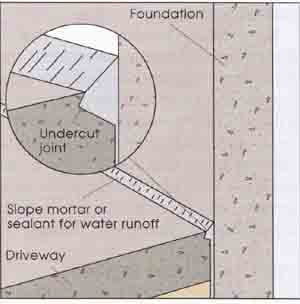
PATCH CRACKS where patios and paving abut the foundation.
Use mortar, latex patching cement, or flexible asphalt sealant.
INSTALLING WINDOW WELLS
If re-grading raises the ground level above the sill of a basement window, protect it with a window well. Purchase a curved plastic or corrugated metal liner that's 6 inches wider than the window. Excavate to a depth of 1 foot beneath the sill, set the liner in place, and pour 4 to 6 inches of gravel into the well. Fill outside the liner with a layer of gravel 2 - 3 inches thick for about two-thirds of the depth of the hole. Finish with earth above, sloped away from the well.
If a window well chronically clogs with leaves, cover it with heavy-duty wire mesh called hardware cloth or with a clear plastic dome available at home centers. A dome will divert rain and snow, as well as windblown debris.
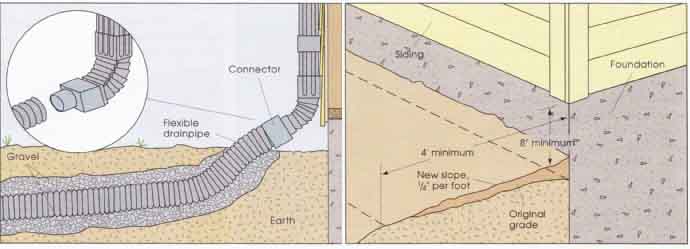
EXTEND DOWNSPOUTS with underground drainpipe. Dig
a trench, line it with gravel, and slope the pipe 1/4 inch per foot away
from the house. Top the pipe with more gravel, earth, and sod. REGRADE
level ground at a foundation by mounding up fill. Create a slope away
from the foundation of at least 1/4 inch per foot over a distance of
4 feet or more.
RESHAPING A SLOPE WITH SWALES
Swales, shallow ditches across a slope, can divert water running down slope to ward a foundation and also help check erosion. Locate swales at the top and bottom of a slope, making them 6 - 10 inches wide and about 6 inches deep. Mark them out by pouring a line of sand along one edge, making sure to maintain a downward pitch in the direction you want the water to go.
For a long run, rent a walk-behind power cultivator to break up the earth along the marked path. That will make shoveling out the swale much easier. Mound up the earth you excavate on the downhill side of each swale. You can plant the swales with grass or other groundcover, fill them with gravel, or convert them into drained contours as explained below.
CAPTURING RUNOFF WITH CONTOURS
Like swales, drained contours capture water coming down a slope and send it elsewhere. To make a contour, cut swales about 12 inches deep across the slope, pour a 2-inch bed of gravel, and install perforated plastic drainpipes. Use gravel that's larger than the holes in the pipes. Cover the pipes with a layer of gravel to prevent dirt from washing in, then fill in with earth and cover with sod. Leave both ends of the drainpipe runs open so you can flush them out with a hose should debris collect inside.
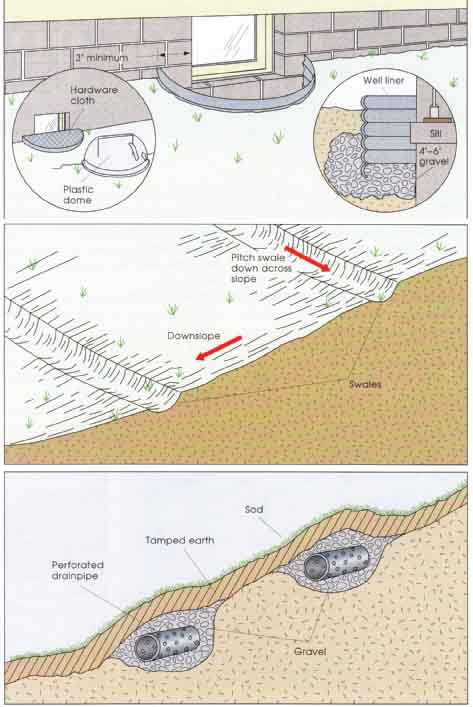
INSTALL WINDOW WELLS at any window with a sill that's below grade. Set a liner in a bed of gravel and backfill against it
with gravel and soil. Cover wells with wire mesh or plastic domes if
leaves and debris are a problem. CUT SWALES into a slope to keep water
away from a foundation. Dig 6-inch-deep trenches and mound soil along
their downhill edges. CONTOURS turn swales into ridges. Lay perforated
drainpipe and gravel in a trench pitched ¼-inch per foot across the slope.
Cover with gravel and earth.
CAUTION
Check your community code before modifying your yard’s drainage patterns. Most codes prohibit routing water toward a neighbor’s property. Many, however, do allow you to drain runoff into the street or a storm sewer, but never into a sanitary sewer.
Other articles in this series: Complete Step-by-Step Home Repair and Improvement